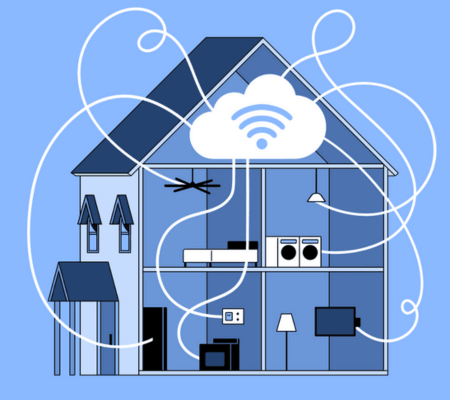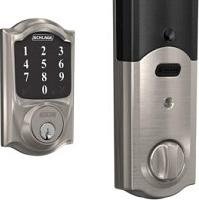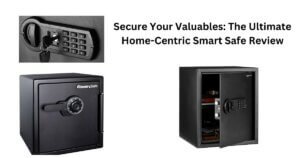Home security systems are becoming increasingly popular as people seek to protect their homes and loved ones from intruders. However, many security systems require a monthly subscription fee, which can add up over time. Fortunately, several home security systems that do not require a subscription are available, making them a more affordable option for homeowners.

One of the best home security systems without a subscription is a DIY system that allows homeowners to install and monitor their security equipment. These systems typically include a base station, sensors, and cameras that can be easily installed without needing professional installation.
Another option for homeowners looking for a security system without a subscription is a system that uses local storage instead of cloud storage. These systems store video footage and other data on a local hard drive or memory card rather than on a remote server. Homeowners do not need a monthly subscription fee to access their security footage. However, it is important to note that local storage systems may have limited storage capacity and may not offer the same level of security as cloud-based systems.
Related: The Truth About Home Security Systems: DIY Home Security
Table of Contents
ToggleEssential Features of Subscription-Free Home Security Systems
Home security systems are essential to keep your home and family safe. However, many systems require a monthly subscription fee, which can add up over time. Fortunately, there are subscription-free home security systems available that offer reliable protection without the added cost. Here are some essential features to look for when choosing a subscription-free home security system:
a. Wireless Connectivity
Wireless connectivity is a crucial feature to look for in a subscription-free home security system. A wireless system is easy to install and can be moved around your home without additional wiring. This feature also makes connecting your security system to your smartphone or tablet easy, allowing you to monitor your home from anywhere.
b. Motion Detection
Motion detection is another essential feature in a subscription-free home security system. This feature allows the system to detect movement and trigger an alarm if an intruder is detected. Some systems also have a mobile app that alerts your phone when detecting motion.
c. Video Monitoring
Video monitoring is a great feature in a subscription-free home security system. This feature lets you view live video footage of your home from anywhere, so you can keep an eye on your property even when you’re not there. Some systems also offer cloud storage for video footage so you can access it later.
d. Smart Home Integration
Smart home integration is becoming more popular in subscription-free home security systems. This feature lets you connect your security system to smart home devices like smart locks and lights. This integration allows you to control all your devices from one app, making managing your home security and other smart home features easy.
e. Battery Backup
Finally, a battery backup is an essential feature to look for in a subscription-free home security system. This feature ensures your system will continue functioning even during a power outage. A battery backup is especially important if you live in an area prone to power outages or extreme weather conditions.
These essential features will help you choose a subscription-free home security system that meets your needs and keeps your home and family safe.
Top 3 Rated Security Devices Without Monthly Fees
Home security is a top priority for homeowners, but the cost of monthly subscription fees can add up quickly. Fortunately, many top-rated security devices do not require a monthly subscription fee. This section will explore some of the best security devices without monthly fees.
A. Security Cameras
Security cameras are an essential part of any home security system. They allow homeowners to monitor their property and deter potential intruders. Many security cameras require a monthly subscription fee for cloud storage, but some offer local storage options. The following are some of the best security cameras without monthly fees:
1. Wyze Cam

This camera offers 1080p HD video, night vision, and two-way audio. It also has free 14-day cloud storage and the option to use a microSD card for local storage.
2. Reolink Argus 2
This wireless and weatherproof camera is ideal for outdoor use. It offers 1080p HD video and allows local storage using a microSD card or Reolink’s cloud storage plan.
3. Blink Indoor
This camera offers 1080p HD video, motion detection, and two-way audio.
It also has free cloud storage for up to two hours of video clips.
B. Smart Doorbells
Smart doorbells are becoming increasingly popular, allowing homeowners to see and speak to visitors from anywhere using their smartphones. Many smart doorbells require a monthly subscription fee for cloud storage, but some offer local storage options. The following are some of the best smart doorbells without monthly fees:
1. Eufy Security Video Doorbell
Eufy Security Video Doorbell E340 offers 1080p HD video, two-way audio, and facial recognition. It also has local storage using a microSD card or Eufy’s HomeBase storage device.
2. RemoBell S
RemoBell S WiFi Video Doorbell Camera offers 1080p HD video, two-way audio, and customizable motion detection zones. It also has the option for local storage using a microSD card or RemoBell’s cloud storage plan.
3. Essential Video Doorbell Wire-Free
Essential Video Doorbell Wire-Free offers 1080p HD video, two-way audio, and motion detection. It also has free cloud storage for up to seven days of video clips.
C. Motion Sensors
Motion sensors are important to any home security system as they can detect movement and alert homeowners of potential intruders. Many motion sensors require a monthly subscription fee for monitoring services, but some offer local storage options. The following are some of the best motion sensors without monthly fees:
1. Kangaroo Motion + Entry Sensor:
Kangaroo Home Security System sensor offers motion and entry detection. It also has the option for local storage using a Kangaroo siren and keypad.
2. Wyze Sense:
Wyze Home Security Core Kit: Hub, Keypad, Motion Sensor, and Entry Sensors offer motion and door/window open/close detection. It also has the option for local storage using a Wyze Cam or Wyze Base Station.
3. Philips Hue Motion Sensor:
This sensor offers motion detection and can be integrated with Philips Hue smart lights. It does not require a subscription fee for use.
D. Alarm Systems
Alarm systems are an effective way to deter intruders and alert homeowners of potential threats. Many alarm systems require a monthly subscription fee for monitoring services, but some offer local storage options. The following are some of the best alarm systems without monthly fees:
1. SimpliSafe Alarm System
SimpliSafe alarm system offers 24/7 professional monitoring, but it also has the option for local storage using a SimpliSafe base station.
2. Ring Alarm Home Security System
Ring Alarm system offers 24/7 professional monitoring, but it also has the option for local storage using a Ring base station and a microSD card.
3. Abode iota:
Abode alarm system offers 24/7 professional monitoring, but it also has the option for local storage using a microSD card or Abode’s cloud storage plan.
Author Verdict
Finally, homeowners do not have to sacrifice security for affordability. Many top-rated security devices are available that do not require a monthly subscription fee. By investing in these devices, homeowners can have peace of mind knowing that their homes are protected without breaking the bank.
Choosing a reliable and high-performing security system is essential for protecting your home and family. By selecting a non-subscription system, you can ensure that your system is both reliable and cost-effective, giving you peace of mind knowing that your home is secure.
Integration with Smart Home Ecosystems
When choosing a home security system, it is important to consider its ability to integrate with other smart home devices and systems. An integrated system can provide a more comprehensive and efficient security solution, allowing users to control and monitor their security system alongside other smart home devices from a single app or interface.
Many non-subscription home security systems integrate with popular smart home ecosystems, such as Amazon Alexa, Google Home, and Apple HomeKit. This integration allows users to control their security system using voice commands or through their smart home hub, making it more convenient and accessible.
In addition to voice control, integration with smart home ecosystems can provide additional features and benefits. For example, users can create automations that trigger their security system when they leave the house or detect motion in specific areas of their home. They can also receive alerts and notifications on their smart devices when their security system detects an intrusion or other security event.
When considering integration with smart home ecosystems, it is important to check compatibility with the devices and systems you already have. Some non-subscription home security systems may not be compatible with certain smart home devices or systems, so it is important to research before purchasing.
Overall, integration with smart home ecosystems can provide a more convenient and comprehensive home security solution for users, allowing them to control and monitor their security system alongside other smart home devices from a single app or interface.
Comparing DIY and Professional Security Systems Without Subscriptions
Regarding home security systems, there are two main options:
DIY and professional. Both systems can be purchased without a subscription, meaning homeowners can avoid monthly fees and have more control over their security.
DIY Security Systems
DIY security systems are designed to be installed by the homeowner without needing professional installation. These systems typically come with sensors and cameras that can be placed around the home and a central hub that connects to the internet and sends alerts to the homeowner’s smartphone or computer.
One of the main advantages of DIY security systems is that they are often more affordable than professional systems. Homeowners can purchase the components they need and install them independently, saving them money on installation fees.
However, DIY systems do have some limitations. They may not be as reliable as professional systems or offer the same level of support and monitoring. In addition, homeowners may need to troubleshoot any issues that arise independently.
Professional Security Systems
A trained technician typically installs professional security systems. These systems often come with a range of sensors, cameras, and other components that are designed to provide comprehensive security coverage.
One of the main advantages of professional systems is that they are often more reliable than DIY systems. They are also typically backed by a team of professionals who can support and monitor around the clock.
However, professional systems can be more expensive than DIY systems in terms of installation and monthly subscription fees. Homeowners may also have less control over their security, as the security company typically manages the system.
DIY and professional security systems can effectively provide home security without a subscription. Homeowners should carefully consider their needs and budget before choosing a system and research different options to find the best fit for their home.
Benefits of Owning a No-Subscription Home Security System
A no-subscription home security system has several advantages over traditional subscription-based systems. Here are some benefits of owning a no-subscription home security system:
1. No Monthly Fees
One of the most significant advantages of a no-subscription home security system is no monthly fees. Subscription-based systems require homeowners to pay a monthly fee to access their security system. This fee can add up over time and be a significant expense for homeowners. With a no-subscription system, homeowners can save money and still have access to a reliable security system.
2. Easy to Install
No-subscription home security systems are easy to install and set up. These systems typically come with easy-to-follow instructions and can be installed in a few hours. This means that homeowners can set up their security systems without needing professional installation, which can be expensive.
3. No Long-Term Contracts
Subscription-based home security systems often require homeowners to sign long-term contracts, which can be difficult to break if the homeowner decides to switch to a different system. With a no-subscription system, homeowners are not locked into a long-term contract and can switch to a different system anytime.
4. Customizable
No-subscription home security systems are highly customizable and can be tailored to the homeowner’s needs. These systems often include a variety of sensors, cameras, and other devices that can be added or removed as needed. This means homeowners can create a security system tailored to their needs and budget.
A no-subscription home security system is an excellent choice for homeowners who want a reliable and customizable security system without needing monthly fees or long-term contracts. These systems are easy to install, highly customizable, and can give homeowners peace of mind knowing their home is protected.
Installation and Maintenance Tips
Self-Installation Guide
Installing a home security system without a subscription can be daunting, but it is possible to do it yourself. Before starting the installation process, reading the user manual and understanding the system’s components is important.
The first step in the installation process is determining the control panel’s location. The control panel is the brain of the security system, and it should be installed in a central location that is easily accessible.
Next, install the sensors and detectors. These include door and window sensors, motion detectors, and glass break sensors. Place the sensors and detectors in strategic locations throughout the home to provide maximum coverage.
Once the sensors and detectors are in place, it is time to install the alarm. The alarm should be loud enough to alert the homeowner and neighbors in an emergency.
Finally, test the system to ensure that it is working properly. Test the sensors and detectors, and ensure the alarm sounds when triggered.
Maintenance Best Practices
Maintaining a home security system is just as important as installing it. Regular maintenance ensures that the system is working properly and provides maximum protection.
One of the most important maintenance tasks is to test the system regularly. Test the sensors and detectors, and ensure the alarm sounds when triggered.
Another important maintenance task is to keep the system clean. Dust and debris can interfere with the sensors and detectors, so it is important to clean them regularly.
In addition, it is important to keep the system up to date. Check for firmware updates and install them as soon as they become available.
Finally, regularly replacing the sensors and detectors’ batteries is important. Most sensors and detectors have a 3-5-year battery life, but checking the user manual for specific instructions is important.
By following these installation and maintenance tips, homeowners can ensure that their home security system without a subscription is working properly and providing maximum protection.
Security System Reliability and Performance
Regarding home security systems, reliability, and performance are two critical factors that homeowners should consider. A reliable security system can detect and alert you of potential threats in real-time. A system that is not reliable may fail to detect intruders or other security breaches, leaving your home vulnerable to theft or other crimes.
Performance is also an important factor to consider when choosing a home security system. A system with good performance will be able to detect and alert you of any potential threats quickly and accurately. This means you can respond to any security breaches on time, reducing the risk of damage or loss.
One way to ensure that your security system is reliable and performs well is to choose a system that does not require a subscription. Subscription-based security systems may not be as reliable as non-subscription systems, as they may rely on third-party monitoring services that may not always be available or accurate.
On the other hand, non-subscription security systems are often more reliable and perform better, as they are designed to work independently of any third-party services. They may also be more cost-effective in the long run, as you will not have to pay monthly fees for monitoring services.
Some examples of non-subscription security systems include DIY systems that you can install yourself and professionally installed systems that do not require ongoing monitoring services. These systems may use various technologies, such as motion sensors, door and window sensors, and video cameras, to detect and alert you of potential threats.




















